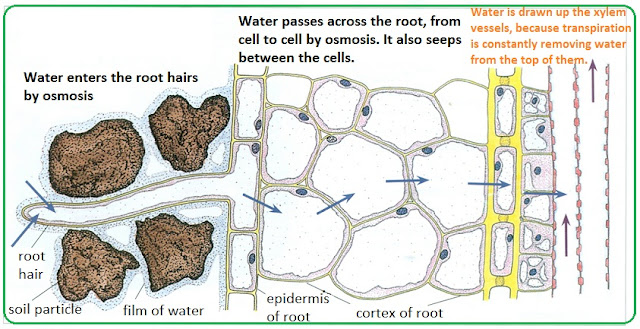Water enters root hair cells by osmosis. This happens when the water potential in the soil surrounding the root is higher than in the cell à water diffuses from the soil into the root hair, down its concentration gradient.
- As the water enters the cell, its water potential becomes higher than in the cell next to it, e.g. in the cortex. So water moves, by osmosis, into the next cell. Some of water may also just seep through the spaces between the cells, or through the cell walls, never actually entering a cell.
- Water vapour evaporating from a leaf crates a kind of suction, its pressure at the top of the vessels is lower than that at the bottom à water move up the stem in the xylem, more water is drawn into the leaf from the xylem. This creates a traspiration stream, pulling water up from the root. Mature xylems cells have no cell contents, so they act like open-ended tubes allowing free movement of water through them. Roots also produce a root pressure, forcing water up xylem vessels.
- Water moves from xylem to enter leaf tissues down water potential gradient. In the leaves, water passes out of the xylem vessels into the surrounding cells.
Common misconceptions
Water does not travel through xylem vessels by
osmosis. Osmosis involves the movement of water across cell membranes – xylem cells
do not have living contents when mature, so there will be no membranes.
Try this
Describe how the
structure of xylem tissue is adapted to its functions.
The cells join together to make a long tubular
structure.
There are no cross-wall and no living contents so the water and mineral salts can pass through freely.
There are no cross-wall and no living contents so the water and mineral salts can pass through freely.
Describe the mechanism of water movement through the xylem.
Water moves by the pull from the leaves caused by the
transpiration.
Xylem vessels are very thin, so they act like a capillary
tube helping to withdraw water upward.
1. a) Labell all parts of the root hair cell (5 mark)
b) Which plant cell part is missing from this cell? (1 mark)
c) Name the process by which the cell absorbs:
i)Water (1 mark)
ii)Minerals (1 mark)
Answer:
a)
b) Chloroplast
c) i) osmosis
ii) diffusion or active transport (or active uptake)




No comments:
Post a Comment